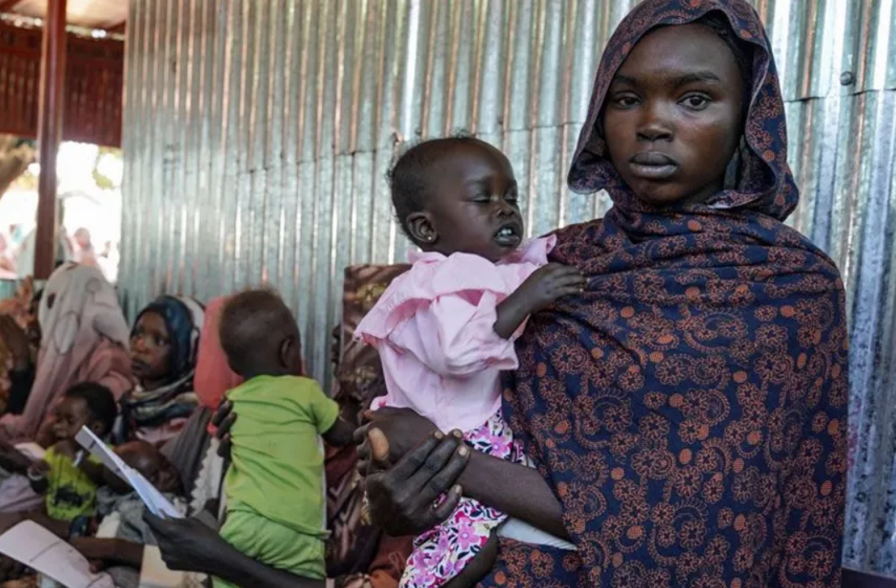Emergence of a Hunger Crisis in the Zamzam Camp of Sudan Amidst the Civil War
Zamzam camp, which is located near the besieged city of el-Fasher in Darfur and is home to around 500,000 displaced people, has been declared a state of famine by an independent committee of food security specialists as a result of the ongoing civil war in Sudan. Based on their analysis of current data, the Famine Review Committee (FRC) concluded that the 16-month conflict and limits on assistance deliveries have worsened the crisis.
The Humanitarian Crisis and the Escalation of Violence
“The scale of devastation brought by the escalating violence in el-Fasher is profound and harrowing,” the FRC wrote, acknowledging the dramatic increase in the population of the Zamzam camp since April. Ten million people have lost their homes as a result of the world’s worst humanitarian catastrophe, which began with the Sudanese army’s brutal power battle with the paramilitary Rapid Support Forces (RSF).
Nearby Negotiations Mediated by the United States
It appears that the US-mediated discussions, which were supposed to start in two weeks, are now in danger because this crisis has occurred at the same time. The RSF has committed to going to Geneva for the talks. However, the army’s participation is still up in the air after Wednesday’s claimed assassination attempt on Gen. Abdel Fattah al-Burhan.
Sources of Food Insecurity
The FRC brought attention to the fact that the continuing violence and the inability to provide humanitarian aid were the primary causes of the starvation in the Zamzam camp. These problems could be solved right away if there was the political will to do so. The committee examined two important studies as part of the Integrated Food Security Phase Classification (IPC), a worldwide effort by governments, relief organizations, and UN agencies to determine when famine is occurring:
According to the most recent assessment by the IPC’s Sudan working group, 54% of the population, or 25.6 million people, are facing severe acute food insecurity, and 14 regions are in danger of starvation.
Famine may also be happening at the Abu Shouk and Al Salam camps close to el-Fasher, according to data published on Thursday by the US-based Famine Early Warning Systems Network (FEWS NET); however, there is no definitive proof of this.
Requirements for Pronouncing a Famine
Two out of every 10,000 people die every day from starvation or diseases associated with malnutrition; thirty percent of children suffer from acute malnutrition, and twenty percent of households experience an extreme scarcity of food. In such a situation, famine is declared.
The Cost to Humanity
El-Fasher is a strategic city in the Darfur region, and the RSF has been trying to capture it from the army since April. About 320,000 people have left the city, with 150,000 to 200,000 taking shelter in Zamzam camp in May alone, according to the FRC. During that month, the UN expert on genocide prevention issued a dire warning about the increasing possibility of genocide in el-Fasher, stating that numerous civilians were being targeted due to their ethnicity. Similarities between the ethnic cleansing wreaked on non-Arab populations twenty years ago by Arab Janjaweed militias and the current conflict in Darfur are striking.
Strains on Zamzam Camp’s Economy
The 47-page report from the FRC provides insight into the terrible situation in Zamzam camp, where the main market is unreliable and where the cost of necessities has soared. Cooking oil saw a 63% increase in price, sugar a 190% increase, millet a 67% increase, and rice a 75% increase in price from April to June. The months of June and July were marked by widespread starvation, and the situation is predicted to worsen right up until harvest time in October. War has prevented many farmers from planting crops therefore the food crisis is not likely to improve dramatically.
Spotlight on the Crisis: Malnutrition
According to Barrett Alexander from the assistance agency Mercy Corps, the reports on el-Fasher, especially the condition in the Zamzam camp, make up only a small portion of the issue. He pointed out that “widespread deaths have already occurred by the time a famine is officially declared.” Nine out of ten children in Central and South Darfur are suffering from life-threatening malnutrition, according to a recent evaluation by Mercy Corps.
There is an immediate need to end the apparent blockage on humanitarian supply; otherwise, conditions in El Fasher could worsen, according to Médecins Sans Frontières (MSF), one of the few remaining aid organizations there. According to Stéphane Doyon, head of emergency for MSF in Sudan, “We have no idea when they will be released.” The trucks were supposed to have reached el-Fasher by now, but they have been stuck in Chad for more than six weeks. The youngsters in Zamzam camp receive therapeutic food and medical supplies on these trucks. Additionally, the last hospital in El-Fasher that does surgery receives surgical materials.
Incidents Involving Medical Institutions
On Monday, three employees died, and at least twenty-five were injured when the Saudi Hospital in el-Fasher was shelled. In less than three months, this is the tenth assault on the hospital. “We do not know if hospitals are being intentionally targeted, but the incident on Monday shows that the belligerents are not taking any precautions to spare them,” he said.
In summary
A horrific example of the wider humanitarian catastrophe caused by the continuing civil war is the starvation in the Zamzam camp in Sudan. To alleviate the suffering of the displaced population, immediate political action and humanitarian access are needed. Even while the world looks to Geneva for possible peace talks, the situation in Sudan, where millions are suffering, is a major worry.



















